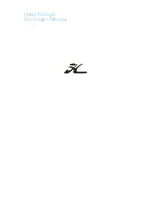
Section 1
Propulsion Systems
1-2
CAUTION
!
DO NOT use copper-based coatings
or any coatings not approved for use
with aluminum. Some paint manufac-
turers claim their paints are safe for
aluminum. Copper components and
copper-based paints can cause severe
corrosion to aluminum. DO NOT use
copper-based paints. Mercury or mer-
cury-based compounds that come
into contact with aluminum will result
in severe corrosion.
1.3 Engine Lubrication
4-cycle engines have an oil sump in the
crankcase. The oil type, grade and level must
be followed in accordance with the engine
manufacturer’s recommendation. It is nor-
mal for 4-cycle engines to consume a small
amount of oil. Check the oil level before each
use and change it following the engine man-
ufacturer’s recommendation.
2-cycle outboard engines are lubricated by
an oil injection system. Check the oil level
before each use and use only type specified
by the engine manufacturer. Also monitor the
oil level by checking the gauge in the helm
or visually checking the oil level in the tank
by using the reference marks on the tanks.
Refer to the engine owner’s manual for oil
specifications and additional information on
the oil injection system. Refer to the Fuel
System Section.
NOTICE
!
Use only the oil recommended by the
engine manufacturer, and monitor the
oil level. Use of any other type of oil
can cause the engine to malfunction
or severe damage.
1.4 Engine Cooling System
Outboard engines are raw water (sea water)
cooled. Water is pumped through the water
inlets, circulated through the engine block,
and expelled with the exhaust through
exhaust port, water port and the propeller
hub. The water pump uses a small impeller
made of synthetic rubber. The impeller and
water pump cannot run dry for more than
a few seconds. In most outboard engines,
some cooling water is diverted through ports
below the engine cowling. This allows the
operator to visually check the operation of the
cooling system. When the engine is started,
make sure a steady stream of water is pres-
ent.
CAUTION
!
DO NOT operate an engine out of the
water, even momentarily. Water must
be supplied to the cooling system
of the power head and water pump,
or serious damage will result. If it is
necessary to run the engine out of
the water, connect it to a engine flush
attachment design for your specific
engine.
If the boat is used in salt or badly polluted
water, flush the engines after each use to
reduce corrosion. Refer to the engine own-
er’s manual for the proper engine flushing
procedure.
Summary of Contents for S 408 SPORT 2017
Page 1: ...OWNER S MANUAL MARCH 2017...
Page 4: ...This page intentionally left blank...
Page 6: ...This page intentionally left blank...
Page 8: ...This page intentionally left blank...
Page 10: ...Safety Information Operator Notes...
Page 14: ...Table of Contents iv Operator Notes...
Page 17: ...Safety Label Locations 3 Exterior 10 19 36 42 19 36 12 15 14 13 18 6 37 11 38 22 7 12 21 40 43...
Page 24: ...Safety Label Locations 10 Operator Notes...
Page 40: ...Section 2 Helm Systems 2 8 Operator Notes...
Page 46: ...Section 3 Fuel Systems 3 6 Operator Notes...
Page 48: ...Section 4 Electrical Systems 4 2 Main Distribution Panel MDP...
Page 61: ...Electrical Systems Section 4 4 15 Operator Notes...
Page 62: ...Section 4 Electrical Systems 4 16 Operator Notes...
Page 72: ...Section 5 Plumbing Systems 5 10 Operator Notes...
Page 74: ...Section 6 Ventilation Systems 6 2 Operator Notes...
Page 82: ...Section 7 Exterior Equipment 7 8 Operator Notes...
Page 88: ...Section 8 Interior Equipment 8 6 Operator Notes...
Page 98: ...Section 9 Safety Equipment 9 10 Operator Notes...
Page 110: ...Section 10 Operation 10 12 Operator Notes...
Page 122: ...Section 12 Seasonal Maintenance 12 6 Operator Notes...
Page 130: ...Appendix B B 2 Date Hours Dealer Service Repairs Maintenance Log...
Page 131: ...Appendix B B 3 Date Hours Dealer Service Repairs Maintenance Log...
Page 132: ...Appendix B B 4 Date Hours Dealer Service Repairs Maintenance Log...
Page 133: ...Boating Accident Report Appendix C C 1...
Page 134: ...Appendix C Boating Accident Report C 2...
Page 135: ...Boating Accident Report Appendix C C 3...
Page 136: ...Appendix C Boating Accident Report C 4...
Page 137: ...Boating Accident Report Appendix C C 5...
Page 138: ...Appendix C Boating Accident Report C 6...
Page 139: ...Float Plan Appendix D D 1...
Page 140: ...Appendix D Float Plan D 2...
Page 142: ...Appendix D Float Plan D 4 Operator Notes...
Page 146: ...Appendix E Troubleshooting Guide E 4 Operator Notes...
Page 147: ...Schematics Appendix F F 1...
Page 148: ...Appendix F Schematics F 2...
Page 149: ...Schematics Appendix F F 3...
Page 150: ...Appendix F Schematics F 4...
Page 151: ...Schematics Appendix F F 5...
Page 152: ...Appendix F Schematics F 6...
Page 153: ...Schematics Appendix F F 7...
Page 154: ...Appendix F Schematics F 8...
Page 155: ...Schematics Appendix F F 9...
Page 156: ...Appendix F Schematics F 10...
Page 157: ...Schematics Appendix F F 11...
Page 158: ...Appendix F Schematics F 12...
Page 159: ...Schematics Appendix F F 13...
Page 160: ...Appendix F Schematics F 14...
Page 162: ...Appendix F Schematics F 16...
Page 163: ...Schematics Appendix F F 17...
Page 164: ...Appendix F Schematics F 18...
Page 165: ...Schematics Appendix F F 19...
Page 166: ...Appendix F Schematics F 20...
Page 167: ...Schematics Appendix F F 21 Operator Notes...
Page 168: ...Appendix F Schematics F 22 Operator Notes...
Page 176: ...Appendix G Additional Information G 8 Operator Notes...
Page 177: ...This page intentionally left blank...
Page 178: ......
















































